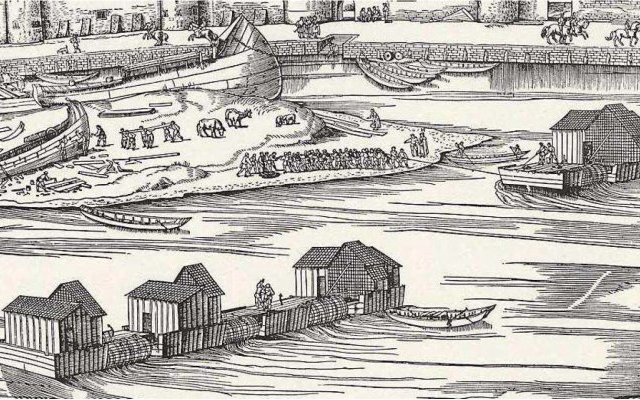David A. Bainbridge, environmental scientist who worked at the Dry Lands Research Institute at the University of California, assert that: « clay pot irrigation is one of the most efficient systems known, thought to have originated in China thousands of years ago. Filled with water, a buried, unglazed, porous clay pot provides controlled irrigation by capillary flow to plants planted near it. »
And in fact, with pit farming, clay pot irrigation has been described 2000 years ago as the key of success to cultivate in arid condition by the famous chinese agronomist Fan Shengzhi.
Nowadays, farmers continue to use buried clay pots to irrigate their crops in North Africa, China, India, Pakistan, Iran, Mexico, Brazil, Ethiopia, etc.

- Installation of irrigation clay pots in our garden (Nyamata Rwanda -December 2017)
For this purpose, jars are buried vertically, leaving the neck visible above the ground by a few centimeters. The soil is then packed around the necks. Since the wall of the jar is porous, the water that is poured into it seeps outward and slowly infiltrates the soil, keeping the moisture at the roots of the plants grown around it.
As the water seeps underground, evaporation from the soil surface is almost prevented. Isolated by the surrounding soil, the water that remains cool helps regulate soil temperature. The soil surface remains dry, so weeds do not thrive. Automatic line return

For Saleh Matanda, executive director of the Pakistan-based Center for Rural Change, who has conducted successful pilot experiments, "the rate of water infiltration depends on the type of plant and soil, and the climatic conditions. Once the surrounding soil becomes saturated, the water re-infiltrates the pot, filling it up again. The system is self-regulating and water losses are negligible.
The mode of lateral and vertical water diffusion also depends on the shape of the long, narrow or wide, shallow jars. Depending on the shape, the size of the jar, the temperature and the requirements of the plants, it will only be necessary to fill the jar once or twice a week, its range would be about 30 cm in diameter. The actual amount and timing of water applications must be determined on a case-by-case basis based on local experience. Careful observation and testing are needed to optimize the system variables that can be manipulated.”
Clay jar irrigation is described as particularly appropriate for fruit trees, but it can also be used to irrigate row crops.
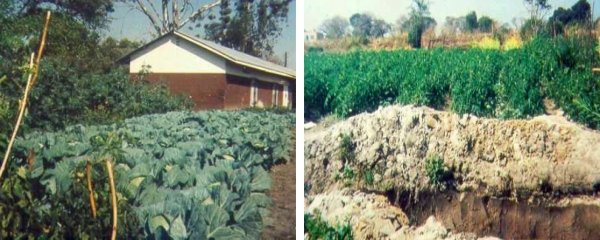
- Cabbage and tomatoes irrigated by buried clay pots in Zambia
David A. Bainbridge describes his own experience of burried clay pot irrigation in these words:
« After reading excerpts from Fan Shengzhi book, I headed out to the garden at the University of California, Riverside, to install some clay pots. Sure enough, they worked — and worked well — with very little water. In a subsequent test in the California desert, I found that all the trees on buried clay pots were alive and healthy after eight months, while all of the trees receiving the same amount of water with conventional basin irrigation had died.
The following spring I started exploring the use of buried clay pots for growing vegetables. I found that melons and squash grew very well and had minimal weeds, despite an appalling level of weed seeds in the university community garden beds. I also grew some Hopi corn (Zea mays) in my shaded back yard with only one-tenth the conventional water use for corn in California.
Meanwhile, I learned that buried clay pot irrigation was still being used on a limited basis in the drylands of India, Pakistan, Iran, the Middle East, and Latin America. The yield of melons grown this way in India, for example, was almost 20 times higher per gallon of water than flood irrigation in California. (I also met a Mexican farmer who put his son through college with clay-pot irrigated melons!) In Ethiopia’s semiarid northeast, tomato production was 50 percent higher than with furrow irrigation. In another study, buried clay pots allowed farmers to grow two crops of corn a year, enabling a family to meet their corn needs with only one-tenth of an acre.
Buried clay pot irrigation has been used successfully for a wide range of perennial plants, including citrus, fruit, and nut trees, from pistachio groves in Iran to dry orchards in India to forests in Pakistan. Many of my desert restoration projects in California have been successful with this technique too. »
David A. Bainbridge, Gardening With Less. Use uo to 90% less water in yur Garden. Low-Tech, Low-Cost Techniques, Storey Publishing, 2015.

- Demand-responsive irrigation is the most efficient. In the photo above, the front row is being irrigated by buried clay pots and the next row by porous capsules. (David A. Bainbridge)
According to pilot experiments conducted in Pakistan, in sandy loam soils :
 creeping vegetables such as cucumber, okra, eggplant, and bitter gourd require 2,000 to 2,500 pitchers per hectare;
creeping vegetables such as cucumber, okra, eggplant, and bitter gourd require 2,000 to 2,500 pitchers per hectare;
 vertical crops developing canopies, such as beans, tomatoes, leeks and melons, need up to 4,000 to 5,000 pots per hectare.
vertical crops developing canopies, such as beans, tomatoes, leeks and melons, need up to 4,000 to 5,000 pots per hectare.
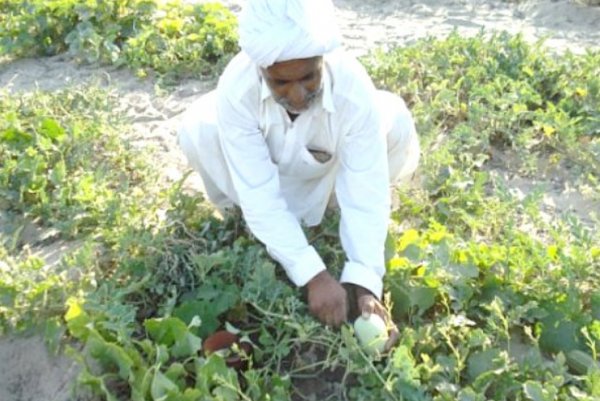
- Pakistani farmer using this irrigation system. The neck of the buried jar can be seen on his right
Optimizing irrigation capabilities
To obtain the best results, the jars must be fired over a relatively moderate fire and of course not be glazed or varnished to remain permeable. If you want to make them yourself, it will take several trials and errors to achieve the best crush resistance, permeability, shape and capacity.
Vessels can be tested for porosity by spraying them with water and ensuring that the surface becomes immediately wet, or by placing them in a bucket of water and ensuring that the water wets them completely.
The flared shape and long neck seems important for the circulation of water and the preservation of freshness, it is also essential to plug the end with a saucer itself in clay or failing that with a pebble or even with a wooden lid.

If narrow-necked jars are not available, standard red clay pots available in a wide range of sizes can be used and are more easily found. The bases that are sold with these jars also make excellent lids.
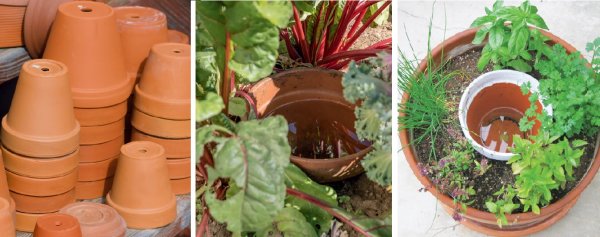
Water usually takes between 24 and 72 hours to circulate through a jar. The transpiration of the jar can be initiated by soaking it before putting it in the ground. To maintain their effectiveness, the jars should also be refilled when the water level drops by half; this measure maintains optimal humidification and avoids the possible accumulation of mineral salts that could hinder infiltration.
The roots of the plants grow around the jars and take only the moisture they need, without wasting a single drop of water. The jar irrigation system virtually eliminates the runoff and evaporation common in modern irrigation methods, allowing the plant to absorb almost all of the water. This method of irrigation ensures that the soil is not soggy, but sufficiently moistened. Due to the tension effect of the soil moisture content, the seepage stops as soon as the soil is sufficiently moist. Because of the permanent moisture content of the soil below the surface, soil compaction, which is a common consequence of surface watering, is reduced.
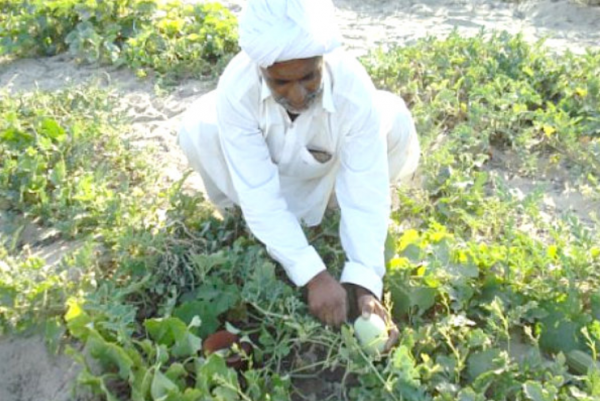
- Paysan Pakistanais utilisant ce système d’irrigation. On aperçoit le col de la jarre enterrée sur sa droite
Potentialities
This irrigation technique would be twice as efficient as surface drip and ten times more than conventional surface irrigation. Bill Mollison in the film series, “The global gardener” or Angel Elias Daka at the end of his thesis do not hesitate to asset that this technique is “the most efficient method of local irrigation of plants in drylands".
“The clay pot sub-surface irrigation technology saves between 50 and 70 % of water as compared to conventional watering can and bucket systems. This technology can combine well with the treadle pump by using the latter to refill water in the former, thus making it easy to fill the system once the water is depleted.”
Angel Elias Daka thesis abstract
System duration and maintenance
The porous jar irrigation system is very simple, but it must be continuously maintained at all times to maintain its potential.
The life of the jars depends on several factors, including the rate at which they become fouled by turbid water (containing clay or suspended organic matter) or by saline water. The acidity of water and soil can affect the durability of jars, especially if they are made of material containing limestone fragments.
It is necessary to take care that the rambling of animals or the trampling of the irrigated area do not lead to the crushing of the pots or to their clogging by the inadvertent fall of loose soil. These problems will be reduced or non-existent if the irrigated plots are fenced and the presence of the jars made obvious by the signs.
It is important to keep the jars filled so that seepage is optimal. When the level drops below half the capacity of the jars, there is a risk of clogging the pores that allow seepage due to the possible accumulation of mineral salts.
As keeping the jars in the ground without water leads to the clogging of the micropores, the jars must be dug up, washed, dried and stored in a safe place when not in use
When the pores are clogged hydrochloric acid can be used to restore the porosity of the walls.
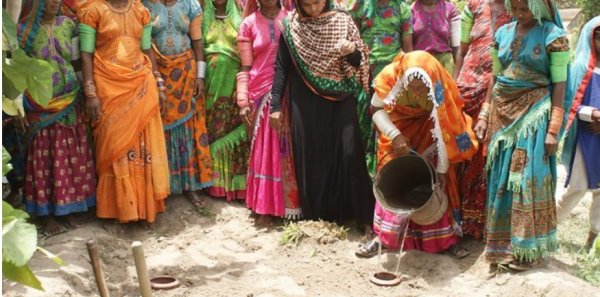
- Training «workshop» for women in India
Possible improvements to the traditional technique
Noting that although jar irrigation requires much less water than the traditional watering system, it is still relatively tedious and demanding if water extraction is done manually Angel Elias Daka proposes to couple this technique with that of treadle pumps that he describes in his doctoral research. For this researcher, treadle pumps are a much more efficient and less laborious system for drawing water from wells or rivers. "By connecting a hose to the treadle pump, water can be delivered to the point where it is needed. Jars can be filled directly from the hose or watering containers can be filled near the point where they are used to fill jars. Combining the two technologies in this way can clearly optimize the clay pot system." [Angel Elias Daka, Development of a Technological Package for Sustainable Use of Dambos by Small-Scale Farmers, Thesis, 2001]
The technique can also be "enhanced" with a gravity feed system.
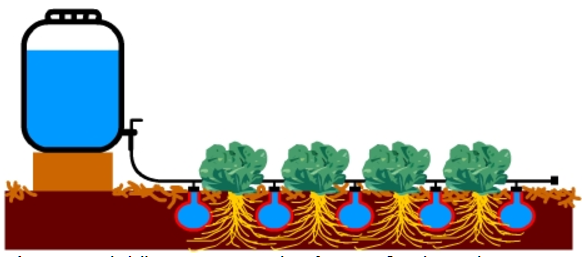
Benefits of earthen clay pot irrigation
 The system is easily implemented
The system is easily implemented
 It is globally a factor of economy, water, work, labor, production security and self-sufficiency.
It is globally a factor of economy, water, work, labor, production security and self-sufficiency.
 The local production of jars creates activities and income.
The local production of jars creates activities and income.
 When produced locally, the jars are cheap and accessible.
When produced locally, the jars are cheap and accessible.
 This technique allows to sow in situ instead of cultivating in nursery and then in the ground. The pots are installed directly where the seeds must germinate around the periphery of the clay pot.
This technique allows to sow in situ instead of cultivating in nursery and then in the ground. The pots are installed directly where the seeds must germinate around the periphery of the clay pot.
 The system is suitable for vegetables as well as horticultural perennials.
The system is suitable for vegetables as well as horticultural perennials.
 This technique can also be used to establish forest crops but the root growth of perennial woody plants will probably break the jars.
This technique can also be used to establish forest crops but the root growth of perennial woody plants will probably break the jars.
 Water loss due to deep percolation beyond the root zone is greatly reduced if not avoided. 50 to 70% water savings are achieved for vegetable crops.
Water loss due to deep percolation beyond the root zone is greatly reduced if not avoided. 50 to 70% water savings are achieved for vegetable crops.
 The induced soil moisture, which almost corresponds to the field capacity, is always available. This property prevents the risk of dehydration and over-irrigation.
The induced soil moisture, which almost corresponds to the field capacity, is always available. This property prevents the risk of dehydration and over-irrigation.
 The lower quantity and frequency of watering reduces the workload and labor required for irrigation and also for weeding since weeds do not flourish, the soil surface remains dry during the growing season.
The lower quantity and frequency of watering reduces the workload and labor required for irrigation and also for weeding since weeds do not flourish, the soil surface remains dry during the growing season.
 The need to use fresh water can be reduced by using domestic grey water which can easily be recycled for pot irrigation.
The need to use fresh water can be reduced by using domestic grey water which can easily be recycled for pot irrigation.
 The system allows a saving of fertilizer to be applied [up to 50%] per unit area of land if the fertilizer is added to the irrigation water. The fertilizer is then absorbed by the plants in a small to soluble form.
The system allows a saving of fertilizer to be applied [up to 50%] per unit area of land if the fertilizer is added to the irrigation water. The fertilizer is then absorbed by the plants in a small to soluble form.
 The seedbed under the clay jars does not seal but remains loose and well aerated.
The seedbed under the clay jars does not seal but remains loose and well aerated.
 Irrigation jars can be installed on unlevelled ground.
Irrigation jars can be installed on unlevelled ground.
 The production of irrigation jars can promote the revival of empowering skills, and the development of pottery skills for other applications: fresh water storage, refrigerators without electricity (zeer port).
The production of irrigation jars can promote the revival of empowering skills, and the development of pottery skills for other applications: fresh water storage, refrigerators without electricity (zeer port).
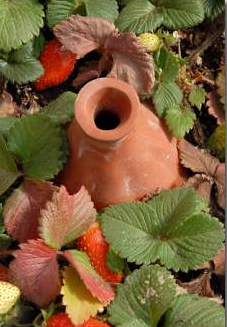
Potential disadvantages
 Prolonged use is likely to decrease porosity.
Prolonged use is likely to decrease porosity.
 The longevity of the jars is unknown but estimated at 5 years or more by one study.
The longevity of the jars is unknown but estimated at 5 years or more by one study.
 Some heavy soils may be inappropriate.
Some heavy soils may be inappropriate.
 This type of jar may be difficult to find locally.
This type of jar may be difficult to find locally.
 In wealthy countries, this type of jar is often prohibitively expensive.
In wealthy countries, this type of jar is often prohibitively expensive.
 Advice on the optimal shape, volume and materials varies from study to study and requires experimental trial and error.
Advice on the optimal shape, volume and materials varies from study to study and requires experimental trial and error.
 Regular monitoring of the system (water level, clogging...) is necessary.
Regular monitoring of the system (water level, clogging...) is necessary.
 The jars must be dug up, washed, dried and stored when not in use.
The jars must be dug up, washed, dried and stored when not in use.
 In climatic zones where it freezes in winter, the jars can break in winter if they remain buried during heavy frosts.
In climatic zones where it freezes in winter, the jars can break in winter if they remain buried during heavy frosts.
Some research findings
- Austin (2006) logically notes that the porosity, size, and shape of jars should be adapted to the water needs of the plants, and vary with the size and distribution of the roots.
 According to Bulten (2006) small volume ollas are suitable for container and pot culture; large ollas are suitable for large containers and open ground.
According to Bulten (2006) small volume ollas are suitable for container and pot culture; large ollas are suitable for large containers and open ground.
 Angel Elias Daka mentions in his 2001 thesis that women in Noole Dambo, Zambia, have successfully installed jars with a capacity of 5 liters each at 50 cm intervals by burying them up to the neck" (AE Daka – 2001).
Angel Elias Daka mentions in his 2001 thesis that women in Noole Dambo, Zambia, have successfully installed jars with a capacity of 5 liters each at 50 cm intervals by burying them up to the neck" (AE Daka – 2001).
- It is intuitive that a more conical, flat-bottomed container with a narrow neck (to reduce evaporation and contamination) should be more efficient because of its increased surface area and theoretically greater water diffusion, and allow fewer containers to be used for the same surface area.
 Jars of 10-12 liters are used to irrigate vines, tomatoes, squash, etc.).
Jars of 10-12 liters are used to irrigate vines, tomatoes, squash, etc.).
- According to John Bulten seeds or plants can be installed around the jars in a band two to five times the radius of the jar. The following figure suggests a potential spacing of jars based on a rough estimate of water spread.
Researcher findings
Padma Vasudevan Sen, Alka Thapliyal, M.G. Dastida and P.K. Sen « Pitcher or clay pot irrigation for water conservation »
“Pitcher irrigation seems to provide a good solution for controlled irrigation. The water flow through the pitcher is seen to be regulated by soil water tension the magnitude of which increases with temperature and decreases with humidity. In the areas where temperatures are very high and other methods of irrigation fail, pitcher or clay pot irrigation can be a promising alternative due to its self regulated water flow according to changes in soil water tension However in addition to this controlled flow, there may be a regular base line flow into the soil through the macro pores in the pitcher wall. This can be reduced by suitable measures for reducing the macropores at the time of fabrication of pitchers and consequent firing.”
Tibebu Tesfaye, Kindie Tesfaye, Kebede Woldetsadik, "Clay Pot Irrigation for Tomato (Lycopersicon esculentum Mill) Production in the North East Semiarid Region of Ethiopia," Journal of Agriculture and Rural Development in the Tropics and Subtropics, Vol. 112 N°. 1 (2011) 11-18
Jars of 26 cm average diameter, 33 cm height, and 8-liter capacity were spaced 96 cm and 125 cm apart in cultivation beds each measuring 5 m x 4.8 m (24 m2). An area of 549 cm2 was occupied by each clay pot.
"The study showed that clay pot irrigation and nitrogen fertilizer application along with irrigation Water prolonged flowering and maturity of tomatoes. Clay pot irrigation and nitrogen fertilization along with irrigation. Water increased the growth. total _yield and marketable yields of tomato than furrow or clay pot irrigation with nitrogen fertilizer applied into the soil. Greater water saving of up to 69% was achieved with clay pot irrigation as compared to furrow irrigation under semi arid condition. The higher yield and lower seasonal water use under clay pot irrigation resulted in superior irrigation Water use efiiciency than furrow irrigation. Nitrogen fertilization with irrigation Water in clay pots improved fertilizer use efliciency of tomato by up to 52% than band application with furrow or clay pot irrigation. Thus, clay pot irrigation with 3- .33; plants ha in combination with nitrogen fertilizer application with irrigation water is recommended for high yield of tomatoes While economizing water and nitrogen fertilizer use in arid and semiarid areas. Similarly, the slow and continuous supply of water by clay pots could be a complement to the growth habit of indeterminate tomatoes. Although it needs an investigation, the number of clay pots required to irrigate a unit of land could also be reduced by using indeterminate tomatoes due to its creeping growth habit. Irrigation Water saving by clay pot irrigation can be further enhanced by altering the porosity of pots and hence, appropriate clay: sand composition, Wall thickness and firing temperature for various vegetables should be further investigated."
AA Siyal, TH Skaggs, "Measured and simulated soil wetting patterns under porous clay pipe sub-surface irrigation", Agricultural water management, 2009 - Elsevier
"In many parts of the world, traditional subsurface irrigation methods can contribute to the conservation of scarce water resources. In this work, experimental and simulation studies were conducted to investigate the soil zones wetted during buried porous clay pipe irrigation.
As the pressure in the irrigation channel increases, the size of the wetted area also increases. The depth of the pipe installation affects the recommended porous pipe spacing. Using shallow installations can result in higher evaporation losses.
For a given water application, the potential evaporation rate from the surface affects the shape of the wetland area minimally. Soil texture, due to its connection to soil hydraulic conductivity and water retention, has a greater impact on wetland geometry. In general, greater horizontal spread occurs in fine-textured soils, and, in the case of stratified soils, in layers with finer texture."
DA Bainbridge, “Buried clay pot irrigation: a little known but very efficient traditional method of irrigation” Agricultural water management, 2001
“Buried clay pot irrigation is one of many very efficient traditional methods of irrigation. It has been used successfully for more than 2000 years and would be much more widely used if farmers and advisors were familiar with its many favorable attributes (Anon, 1974, 1976, 1979; Gischler and Fernandez-Jauregui, 1984; Bainbridge, 1986, 1988; Bainbridge et al., 1998). It is especially useful in difficult conditions of high salinity, extreme aridity, limited water supply, and limited resources. It should be the focus of a major international effort to develop appropriate training materials in a number of languages and for people who are not literate.”
Angel Elias Daka, "Development of a Technological Package for Sustainable Use of Dambos by Small-Scale Farmers", Thesis University of Pretoria, April 2001
1. Clay pot sub-surface irrigation is a drip irrigation system by way of its water application to the plants. Water oozes out through the micro-pores of the pot and wets the surrounding soil. The crops grown around the pot take up the water as they need it.
2. It has been found that as long as the water is not completely depleted in clay pots, it will be in continuous phase of moving out of the pot as long as water uptake by a crop takes place. In this way the surrounding soil is kept moist.
3. The technology is a conservation irrigation system, which saves between 50% and 70% water when compared to the conventional watering can irrigation system. Water is a scarce resource and thus its use must be optimized.
4. Clay pots reduce water use without reducing yields. Therefore it is a water saving technology which optimizes yields per unit water.
5. The clay pot irrigation system is a labour saving technology, both because of less labour required for irrigation and less labour required for weeding.
6. The fact that most rural women of Africa locally make clay pots, means that making clay pots for irrigation will potentially contribute towards creation of employment for them by means of a technology that they are proficient in.
7. The clay pot irrigation system greatly reduces fertilizer requirements, which greatly
improves the economy of small-scale irrigation farming.
8. The clay pot irrigation system could be optimized by combining it with treadle pump technology.












